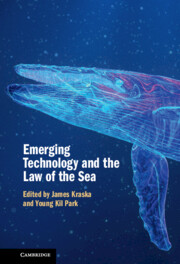Book contents
- Emerging Technology and the Law of the Sea
- Emerging Technology and the Law of the Sea
- Copyright page
- Contents
- Contributors
- Preface
- 1 Emerging Technology and Maritime Boundary Dispute Resolution
- 2 Renewable Energy and the Law of the Sea
- 3 Striking an Equitable Balance under the Biodiversity Agreement
- 4 Small Modular Reactors and Transportable Nuclear Power Plants
- 5 Shipping, Distributed Ledgers and Private Maritime Law
- 6 Maritime Cyber Security
- 7 International Standards for Hull Inspection and Maintenance of Robotics and Autonomous Systems
- 8 Functionalism and Maritime Autonomous Surface Ships
- 9 Artificial Intelligence to Facilitate Safe Navigation of Ships
- 10 Unmanned and Autonomous Warships and Military Aircraft
- 11 Seabed Technology and Naval Operations on the Continental Shelf
- Index
11 - Seabed Technology and Naval Operations on the Continental Shelf
Published online by Cambridge University Press: 07 July 2022
- Emerging Technology and the Law of the Sea
- Emerging Technology and the Law of the Sea
- Copyright page
- Contents
- Contributors
- Preface
- 1 Emerging Technology and Maritime Boundary Dispute Resolution
- 2 Renewable Energy and the Law of the Sea
- 3 Striking an Equitable Balance under the Biodiversity Agreement
- 4 Small Modular Reactors and Transportable Nuclear Power Plants
- 5 Shipping, Distributed Ledgers and Private Maritime Law
- 6 Maritime Cyber Security
- 7 International Standards for Hull Inspection and Maintenance of Robotics and Autonomous Systems
- 8 Functionalism and Maritime Autonomous Surface Ships
- 9 Artificial Intelligence to Facilitate Safe Navigation of Ships
- 10 Unmanned and Autonomous Warships and Military Aircraft
- 11 Seabed Technology and Naval Operations on the Continental Shelf
- Index
Summary
Advances in long-range precision strike missiles, such as cruise missiles, ballistic missiles and hypersonic weapons, threaten the survivability of surface warships. In response, states are deploying submarines in the water column and expanding military activities on the seabed. Concepts such as “upward falling payloads” and networked “hydra” seabed installations envision prepositioned sensors and weapons emplaced on the continental shelf along an adversary’s coast. This chapter explores the legality of military operations on the continental shelf of a coastal state. The coastal state has sovereign rights and jurisdiction over the living and nonliving resources of the seabed and subsoil in accordance with the UN Convention on the Law of the Sea. Foreign military activities are generally permissible on the continental shelf of a coastal state so long as they observe due regard for the resource rights of the coastal state. Coastal states enjoy the exclusive right to construct artificial islands on their continental shelf but they lack competence to regulate military seabed installations and structures on the continental shelf.
Keywords
- Type
- Chapter
- Information
- Emerging Technology and the Law of the Sea , pp. 301 - 326Publisher: Cambridge University PressPrint publication year: 2022

